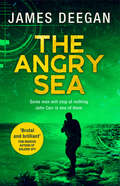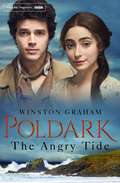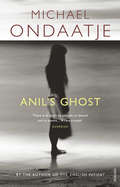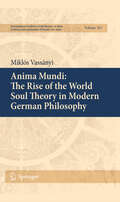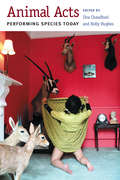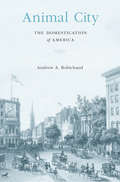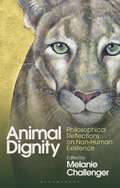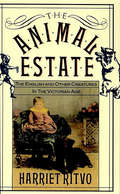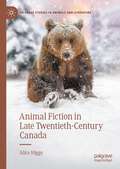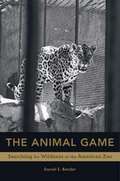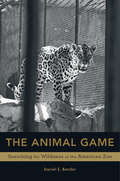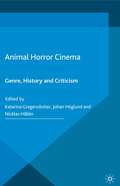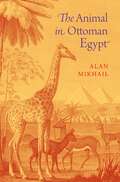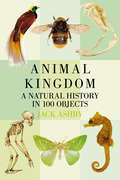- Table View
- List View
Angry Nation: Turkey since 1989 (Global History of the Present)
by Kerem ÖktemSince its re-emergence as nation-state in 1923, Turkey has often looked like an odd appendix to the West situated in the borderlands of Europe and the Middle East, economically backward, inward looking, marred by political violence, yet a staunch NATO ally, it has been eyed with suspicion by both 'East' and 'West'. The momentous changes in the regional and world order after 1989 have catapulted the country back to the world stage. Ever since, Turkey has turned into a major power broker and has developed into one the largest economies in the world. In the process, however, the country has failed to solve its ethnic, religious and historical conflicts peacefully.At this historical turning point, Kerem Oktem charts the contemporary history of Turkey, exploring such key issues as the relationship between religion and the state, Kurdish separatism, Turkey's relationship with Israel and the ongoing controversy over Turkey's entry into the EU. Readable but comprehensive, this is the definitive book on the country's erratic transformation from a military dictatorship to a maturing, if still troubled, democracy.
The Angry Sea (John Carr #2)
by James Deegan‘Brutal and brilliant’ Tom Marcus, author of SOLDIER SPY
The Angry Tide: Cornwall - As The 18th Century Ebbs (Poldark #7)
by Winston GrahamThe basis of the fourth season of the television phenomenon starring Aidan Turner, The Angry Tide is the seventh novel in Winston Graham's hugely popular Poldark series.Cornwall, towards the end of the 18th century. Ross Poldark sits for the borough of Truro as Member of Parliament - his time divided between London and Cornwall, his heart divided about his wife, Demelza. His old feud with George Warleggan still flares - as does the illicit love between Morwenna and Drake, Demelza's brother. Before the new century dawns, George and Ross will be drawn together by a loss greater than their rivalry - and Morwenna and Drake by a tragedy that brings them hope . . .The Angry Tide is followed by the eighth book in the Poldark series, The Stranger From The Sea.
Anil's Ghost (Basic Ser.)
by Michael OndaatjeAnil's Ghost transports us to Sri Lanka, a country steeped in centuries of tradition, now forced into the late twentieth century by the ravages of a bloody civil war. Enter Anil Tissera, a young woman and forensic anthropologist born in Sri Lanka but educted in the West, sent by an international human rights group to identify the victims of the murder campaigns sweeping the island.When Anil discovers that the bones found in an ancient burial site are in fact those of a much more recent victim, her search for the terrible truth hidden in her homeland begins. What follows is a story about love, about family, about identity - a story driven by a riventing mystery.
Anima: A Wild Pastoral
by Kapka Kassabova‘A classic in the making for our times’ MONIQUE ROFFEY‘Haunting, beautiful…Anima will live with me for a long time’ CAL FLYN‘A beautiful book of passion and adventure… She is simply sublime’ HORATIO CLAREThe spellbinding new book by the prizewinning writer Kapka Kassabova tells the story of her time with the last moving pastoralists in Europe: a gripping portrayal of human-animal interdependence, and a plea for a different way of living.Living with one of these communities over the course of one summer, Kassabova experiences the intensity, brutality, beauty and isolation of their existence. She witnesses the epic, orchestrated activity of transhumance – the seasonal movement of vast herds of sheep, along with shepherds and dogs. As she becomes attuned to the sacrifices inherent in this work and the rich histories that shaped this Balkan region, Kassabova finds herself drawn deeper into the tangled relationships at the heart of the small community.Anima is an extraordinary portrayal of pastoral life, where humans and animals exist in profound interdependence. Kassabova conjures the spirit of this remarkable place with intimacy and empathy, and helps us imagine how we might all begin to heal our broken relationship with the natural world.
Anima Mundi: The Rise of the World Soul Theory in Modern German Philosophy (International Archives of the History of Ideas Archives internationales d'histoire des idées #202)
by Miklós VassányiThis work presents and philosophically analyzes the early modern and modern history of the theory concerning the soul of the world, anima mundi. The initial question of the investigation is why there was a revival of this theory in the time of the early German Romanticism, whereas the concept of the anima mundi had been rejected in the earlier, classical period of European philosophy (early and mature Enlightenment). The presentation and analysis starts from the Leibnizian-Wolffian school, generally hostile to the theory, and covers classical eighteenth-century physico-theology, also reluctant to accept an anima mundi. Next, it discusses early modern and modern Christian philosophical Cabbala (Böhme and Ötinger), an intellectual tradition which to some extent tolerated the idea of a soul of the world. The philosophical relationship between Spinoza and Spinozism on the one hand, and the anima mundi theory on the other is also examined. An analysis of Giordano Bruno’s utilization of the concept anima del mondo is the last step before we give an account of how and why German Romanticism, especially Baader and Schelling asserted and applied the theory of the Weltseele. The purpose of the work is to prove that the philosophical insufficiency of a concept of God as an ens extramundanum instigated the Romantics to think an anima mundi that can act as a divine and quasi-infinite intermediary between God and Nature, as a locum tenens of God in physical reality.
Animal Acts: Performing Species Today (Critical Performances)
by Una Chaudhuri Holly HughesWe all have an animal story—the pet we loved, the wild animal that captured our childhood imagination, the deer the neighbor hit while driving. While scientific breakthroughs in animal cognition, the effects of global climate change and dwindling animal habitats, and the exploding interdisciplinary field of animal studies have complicated things, such stories remain a part of how we tell the story of being human. Animal Acts collects eleven exciting, provocative, and moving stories by solo performers, accompanied by commentary that places the works in a broader context. Work by leading theater artists Holly Hughes, Rachel Rosenthal, Deke Weaver, Carmelita Tropicana, and others joins commentary by major scholars including Donna Haraway, Jane Desmond, Jill Dolan, and Nigel Rothfels. Una Chaudhuri’s introduction provides a vital foundation for understanding and appreciating the intersection of animal studies and performance. The anthology foregrounds questions of race, gender, sexuality, class, nation, and other issues central to the human project within the discourse of the “post human,” and will appeal to readers interested in solo performance, animal studies, gender studies, performance studies, and environmental studies.
Animal Acts: Configuring the Human in Western History
by Jennifer Ham Matthew SeniorAnimal Acts records the history of the fluctuating boundary between animals and humans as expressed in literary, philosophical and scientific texts, as well as visual arts and historical practices such as dissection, circus acts, the hunt and zoos. The essays document a persistent return of animality, a becoming animal that has always existed within and at the margins of Western Culture from the Middle Ages to the present.
Animal Acts: Configuring the Human in Western History
by Jennifer Ham Matthew SeniorAnimal Acts records the history of the fluctuating boundary between animals and humans as expressed in literary, philosophical and scientific texts, as well as visual arts and historical practices such as dissection, circus acts, the hunt and zoos. The essays document a persistent return of animality, a becoming animal that has always existed within and at the margins of Western Culture from the Middle Ages to the present.
Animal and Shaman: Ancient Religions of Central Asia
by Julian BaldickWhat common features can be found in the native religions of the vast Eurasian landmass? Julian Baldick, in this comparative study of the indigenous pre-Christian and pre-Muslim religions of Central Asia, argues that there was a common inheritance to be found among the beliefs of the various peoples who have lived in Central Asia or have migrated from there; Scythians, Huns, Turks, Mongols, Manchus, Finns and Hungarians. Shamans - holy men healers among the pagan faiths - relied heavily on animal sacrifices to create spiritual purity and to nourish the soul. Animals and spirituality were thus locked in a mutually dependent embrace. In this survey of the ancient customs and religions of the larger inner Eurasian landmass, Baldick concludes that in pagan times there were remarkable common features in the forms of worship and spiritual expression among the different peoples of Central Asia, all largely based on the role of animals in their lives. These have survived not only in the myths and legends of the region but have also found their way into the mythologies of the West.This ground-breaking study will be of great importance to historians as well as cultural and social anthropologists.
The Animal and the Human in Ancient and Modern Thought: The ‘Man Alone of Animals’ Concept (Routledge Monographs in Classical Studies)
by Stephen T. NewmyerAncient Greeks endeavored to define the human being vis-à-vis other animal species by isolating capacities and endowments which they considered to be unique to humans. This approach toward defining the human being still appears with surprising frequency, in modern philosophical treatises, in modern animal behavioral studies, and in animal rights literature, to argue both for and against the position that human beings are special and unique because of one or another attribute or skill that they are believed to possess. Some of the claims of man’s unique endowments have in recent years become the subject of intensive investigation by cognitive ethologists carried out in non-laboratory contexts. The debate is as lively now as in classical times, and, what is of particular note, the examples and methods of argumentation used to prove one or another position on any issue relating to the unique status of human beings that one encounters in contemporary philosophical or ethological literature frequently recall ancient precedents. This is the first book-length study of the ‘man alone of animals’ topos in classical literature, not restricting its analysis to Greco-Roman claims of man’s intellectual uniqueness, but including classical assertions of man’s physiological and emotional uniqueness. It supplements this analysis of ancient manifestations with an examination of how the commonplace survives and has been restated, transformed, and extended in contemporary ethological literature and in the literature of the animal rights and animal welfare movements. Author Stephen T. Newmyer demonstrates that the anthropocentrism detected in Greek applications of the ‘man alone of animals’ topos is not only alive and well in many facets of the current debate on human-animal relations, but that combating its negative effects is a stated aim of some modern philosophers and activists.
The Animal and the Human in Ancient and Modern Thought: The ‘Man Alone of Animals’ Concept (Routledge Monographs in Classical Studies)
by Stephen T. NewmyerAncient Greeks endeavored to define the human being vis-à-vis other animal species by isolating capacities and endowments which they considered to be unique to humans. This approach toward defining the human being still appears with surprising frequency, in modern philosophical treatises, in modern animal behavioral studies, and in animal rights literature, to argue both for and against the position that human beings are special and unique because of one or another attribute or skill that they are believed to possess. Some of the claims of man’s unique endowments have in recent years become the subject of intensive investigation by cognitive ethologists carried out in non-laboratory contexts. The debate is as lively now as in classical times, and, what is of particular note, the examples and methods of argumentation used to prove one or another position on any issue relating to the unique status of human beings that one encounters in contemporary philosophical or ethological literature frequently recall ancient precedents. This is the first book-length study of the ‘man alone of animals’ topos in classical literature, not restricting its analysis to Greco-Roman claims of man’s intellectual uniqueness, but including classical assertions of man’s physiological and emotional uniqueness. It supplements this analysis of ancient manifestations with an examination of how the commonplace survives and has been restated, transformed, and extended in contemporary ethological literature and in the literature of the animal rights and animal welfare movements. Author Stephen T. Newmyer demonstrates that the anthropocentrism detected in Greek applications of the ‘man alone of animals’ topos is not only alive and well in many facets of the current debate on human-animal relations, but that combating its negative effects is a stated aim of some modern philosophers and activists.
Animal City: The Domestication of America
by Andrew A. RobichaudAmerican urbanites once lived alongside livestock and beasts of burden. But as cities grew, human–animal relationships changed. The city became a place for pets, not slaughterhouses or working animals. Andrew Robichaud traces the far-reaching consequences of this shift—for urban landscapes, animal- and child-welfare laws, and environmental justice.
Animal Dignity: Philosophical Reflections on Non-Human Existence
by Melanie ChallengerHow do we understand the dignity and value of non-human animals? Leading philosophers, ethnologists and writers contribute to this interdisciplinary and wide-ranging account of animal dignity. With a foreword by world-leading primatologist, Dr. Jane Goodall DBE, essays collected here make the case for applying the concept of dignity beyond its usual humanist framework and introduce readers to animal dignity in history, law, science, philosophy, and literature. United in recognizing the dignity of non-human animals, these essays suggest how we might ensure a flourishing environment in times of ecological destruction and climate breakdown. Historians, primatologists, philosophers, novelists and artists approach the concept of animal dignity creatively, offering interpretations that are academically rigorous, alongside ones that are personal and literary. This variety of engagement knits together a fruitful way forward for progressive relations between all species.
Animal Dignity: Philosophical Reflections on Non-Human Existence
How do we understand the dignity and value of non-human animals? Leading philosophers, ethnologists and writers contribute to this interdisciplinary and wide-ranging account of animal dignity. With a foreword by world-leading primatologist, Dr. Jane Goodall DBE, essays collected here make the case for applying the concept of dignity beyond its usual humanist framework and introduce readers to animal dignity in history, law, science, philosophy, and literature. United in recognizing the dignity of non-human animals, these essays suggest how we might ensure a flourishing environment in times of ecological destruction and climate breakdown. Historians, primatologists, philosophers, novelists and artists approach the concept of animal dignity creatively, offering interpretations that are academically rigorous, alongside ones that are personal and literary. This variety of engagement knits together a fruitful way forward for progressive relations between all species.
Animal Electricity: How We Learned That the Body and Brain Are Electric Machines
by Robert B. CampenotLike all cellular organisms humans run on electricity. Cells work like batteries: slight imbalances of electric charge across cell membranes, caused by ions moving in and out of cells, result in sensation, movement, awareness, and thinking—the things we associate with being alive. Robert Campenot offers an accessible overview of animal electricity.
Animal Electricity: How We Learned That the Body and Brain Are Electric Machines
by Robert B. CampenotLike all cellular organisms humans run on electricity. Cells work like batteries: slight imbalances of electric charge across cell membranes, caused by ions moving in and out of cells, result in sensation, movement, awareness, and thinking—the things we associate with being alive. Robert Campenot offers an accessible overview of animal electricity.
The Animal Estate: The English and Other Creatures in Victorian England
by Harriet RitvoWhen we think about the Victorian age, we usually envision people together with animals: the Queen and her pugs, the sportsman with horses and hounds, the big game hunter with his wild kill, the gentleman farmer with a prize bull. Harriet Ritvo here gives us a vivid picture of how animals figured in English thinking during the nineteenth century and, by extension, how they served as metaphors for human psychological needs and sociopolitical aspirations. Victorian England was a period of burgeoning scientific cattle breeding and newly fashionable dog shows; an age of Empire and big game hunting; an era of reform and reformers that saw the birth of the Royal SPCA. Ritvo examines Victorian thinking about animals in the context of other lines of thought: evolution, class structure, popular science and natural history, imperial domination. The papers and publications of people and organizations concerned with agricultural breeding, veterinary medicine, the world of pets, vivisection and other humane causes, zoos, hunting at home and abroad, all reveal underlying assumptions and deeply held convictions—for example, about Britain’s imperial enterprise, social discipline, and the hierarchy of orders, in nature and in human society. Thus this book contributes a new new topic of inquiry to Victorian studies; its combination of rhetorical analysis with more conventional methods of historical research offers a novel perspective on Victorian culture. And because nineteenth-century attitudes and practices were often the ancestors of contemporary ones, this perspective can also inform modern debates about human–animal interactions.
Animal Fiction in Late Twentieth-Century Canada (Palgrave Studies in Animals and Literature)
by Alice HiggsAnimal Fiction in Late Twentieth-Century Canada fulfils a vital contribution to the conversation surrounding animal representation as a point of continuity in national narratives and supports the idea that focusing on narratives of responsibility and care influences better relations with both non-human animals and across settler-Indigenous boundaries. Alice Higgs engages with on-going debates regarding reconciliation by demonstrating that it is imperative to critique settler colonial environmental frameworks and place autonomy back into Indigenous communities by bringing Indigenous practices of custodianship and relationality to bear more generally. This book also develops a number of conversations in animal studies in relation to the politics of representation. Higgs studies a range of canonical Canadian authors, demonstrating a progress across the period in which it is possible to identify the emergence of a literary pro-animal turn.
The Animal Game: Searching For Wildness At The American Zoo
by Daniel E. BenderTracing the global trade and trafficking in animals that supplied U.S. zoos, Daniel Bender shows how Americans learned to view faraway places through the lens of exotic creatures on display. He recounts the public’s conflicted relationship with zoos, decried as prisons by activists even as they remain popular centers of education and preservation.
The Animal Game: Searching For Wildness At The American Zoo
by Daniel E. BenderTracing the global trade and trafficking in animals that supplied U.S. zoos, Daniel Bender shows how Americans learned to view faraway places through the lens of exotic creatures on display. He recounts the public’s conflicted relationship with zoos, decried as prisons by activists even as they remain popular centers of education and preservation.
Animal Horror Cinema: Genre, History and Criticism
by Johan Höglund Katarina Gregersdotter Nicklas HållénThis first full-length scholarly study about animal horror cinema defines the popular subgenre and describes its origin and history in the West. The chapters explore a variety of animal horror films from a number of different perspectives. This is an indispensable study for students and scholars of cinema, horror and animal studies.
The Animal in Ottoman Egypt
by Alan MikhailSince humans first emerged as a distinct species, they have eaten, fought, prayed, and moved with other animals. In this stunningly original and conceptually rich book, historian Alan Mikhail puts the history of human-animal relations at the center of transformations in the Ottoman Empire from the sixteenth to the nineteenth centuries. Mikhail uses the history of the empire's most important province, Egypt, to explain how human interactions with livestock, dogs, and charismatic megafauna changed more in a few centuries than they had for millennia. The human world became one in which animals' social and economic functions were diminished. Without animals, humans had to remake the societies they had built around intimate and cooperative interactions between species. The political and even evolutionary consequences of this separation of people and animals were wrenching and often violent. This book's interspecies histories underscore continuities between the early modern period and the nineteenth century and help to reconcile Ottoman and Arab histories. Further, the book highlights the importance of integrating Ottoman history with issues in animal studies, economic history, early modern history, and environmental history. Carefully crafted and compellingly argued, The Animal in Ottoman Egypt tells the story of the high price humans and animals paid as they entered the modern world.
The Animal in Ottoman Egypt
by Alan MikhailSince humans first emerged as a distinct species, they have eaten, fought, prayed, and moved with other animals. In this stunningly original and conceptually rich book, historian Alan Mikhail puts the history of human-animal relations at the center of transformations in the Ottoman Empire from the sixteenth to the nineteenth centuries. Mikhail uses the history of the empire's most important province, Egypt, to explain how human interactions with livestock, dogs, and charismatic megafauna changed more in a few centuries than they had for millennia. The human world became one in which animals' social and economic functions were diminished. Without animals, humans had to remake the societies they had built around intimate and cooperative interactions between species. The political and even evolutionary consequences of this separation of people and animals were wrenching and often violent. This book's interspecies histories underscore continuities between the early modern period and the nineteenth century and help to reconcile Ottoman and Arab histories. Further, the book highlights the importance of integrating Ottoman history with issues in animal studies, economic history, early modern history, and environmental history. Carefully crafted and compellingly argued, The Animal in Ottoman Egypt tells the story of the high price humans and animals paid as they entered the modern world.
Animal Kingdom: A Natural History in 100 Objects
by Jack AshbyFrom a single beginning, countless millions of stories from the animal kingdom have – and continue to – run their course. Museum objects allow us to investigate some of those stories. Animal Kingdom journeys through both the evolutionary history of animals, and the ways that people have interpreted them in museums. Animals in museums are not only representatives of their entire species, but they also tell us something about the time in which they were collected. They provide windows into the past as well as data for the present. They embody centuries of natural ecosystems and human cultures. Through a selection of 100 objects, telling 100 stories, this beautifully illustrated book explores the diversity of animal life over the past 600 million years, and delves into some of the most exciting mechanisms in evolution. By understanding some of the key stories of how nature operates, we can gain amazing insight into the systems underlying life itself.

